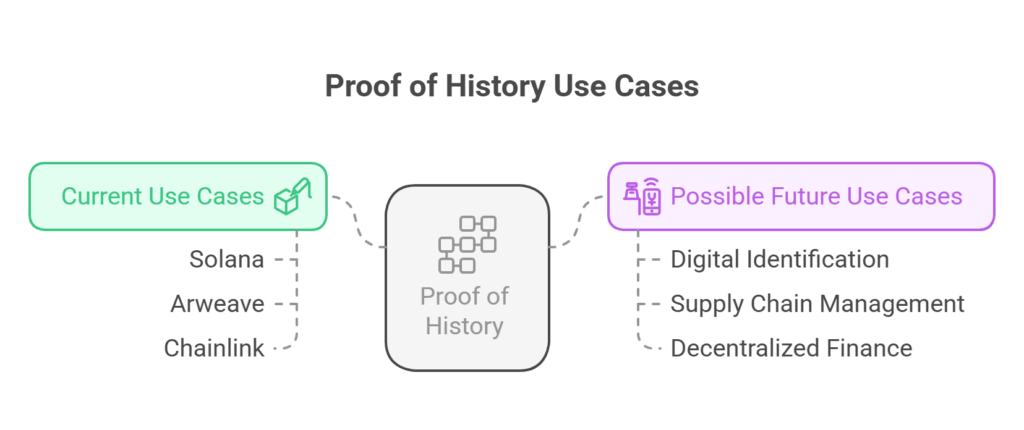What is proof of history?

Blockchain networks employ a new consensus technique called Proof of History (PoH) to confirm the time of each block, guaranteeing the correctness of historical data and the sequence of events. For blockchain networks, it serves as a global time source or a decentralized clock.
Origin:
In November 2017, Solana Labs founder Anatoly Yakovenko presented PoH as a pre-consensus method.
Also Read About What is Proof of Burn In Blockchain? How does PoB work?
How does proof of history work?
Fundamentally, PoH is mostly concerned with time sequencing. It uses a particular cryptographic function to accomplish this:
Verifiable Delay Function (VDF)
To generate timestamps and validate the interval between two blocks, PoH networks rely on the VDF. It is challenging to alter timestamps since the VDF is a cryptographic function that is intended to be both memory-hard and delay-hard. Sequential computation takes a considerable amount of time, but the outcome may be promptly and openly confirmed. To get their allotted block production time, block producers must complete the VDF procedure.
Cryptographic Timestamping
Using a sequential hash function that is resistant to images, cryptographic timestamping is the foundation of PoH. The current state of the Blockchain and a random seed are the inputs for this function, which generates a hash a distinct, irreversible result. This hash functions as a timestamp that can be verified.
Generating a Hash Chain
Solana, a famous PoH user, generates a hash chain by iteratively applying the hash function, using the preceding hash’s output as the input. Each step is a “tick,” and the number of hash operations shows the time. This continual hashing process embeds the transaction sequence in the hashed output, creating a long chain of hashed transactions. With this unambiguous, verifiable sequence, a traditional timestamp is not required.
Recording Transactions
Transactions are recorded by sending the most recent hash that was seen at the time of the transaction. By making sure it refers to a hash in the current PoH sequence, validators verify its timing and validity. A historical record demonstrating that an event took place at a particular time is produced by this technique. It is possible to timestamp data or a hash of data into this sequence by adding it to the state of the function, where the timestamp is represented by the next created hash.
Consensus Integration
Proof of Stake (PoS) and Proof of Work (PoW) are two more consensus techniques that PoH is compatible with, even if its primary function is timekeeping. For instance, Solana increases its resilience and efficiency by combining PoH with Tower Byzantine Generals’ Problem(BFT), a PoS-based algorithm. These algorithms can reach consensus more faster to PoH’s timekeeping.
Core Principles and Characteristics of PoH
Verifiability
PoH guarantees that the Blockchain’s history is open, unchangeable, and available for public inspection. This decreases dependency on computationally demanding procedures while fostering confidence.
Efficiency
PoH increases transaction processing efficiency, expedites consensus, and lowers transaction costs by offering a trustworthy temporal order of events. Because each block only needs to maintain a little amount of data (including the preceding block’s hash and the VDF-generated date), storage and bandwidth costs are greatly reduced.
Decentralization
By allowing multiple nodes to generate and check timestamps simultaneously, decentralization increases network security and reliability by preventing one entity from dominating. Reliance on a single PoH generator at a time, which results in a single point of failure, is a possible problem mentioned.
Fast Finality
PoH usually makes it possible for quick finality, which means that once a block is added to the blockchain, it is definitive and cannot be undone.
Benefits of Proof of History
- PoH boosts network scalability, allowing hundreds of millions of transactions per second to be processed economically. Solana manages over 60,000 TPS and targets millions.
- Consistent Ordering & Timely Agreement: It allows blockchain events to be arranged consistently, which is important for decentralized networks where international consensus on transaction order can be problematic.
- Transaction processing is faster with minimal latency.
- High Security: The network’s overall security and the accuracy of the historical record are guaranteed by the VDF’s difficulty of manipulation. In addition, it offers built-in protection against long-range attacks and, when paired with Proof of Replication, can prevent ledger forgery.
- PoH networks are energy efficient and reduce their global carbon footprint since they require fewer computational resources than Proof of Work systems.
Proof of work Vs Proof of history
- PoH networks simply use the VDF for timestamps, unlike PoW and PoS, which use computational power or economic stake for consensus.
- PoH quickly finalises deals, making them irrevocable. Therefore, there is always a slight risk that a block will be rejected or reversed in PoW and PoS.
- PoH significantly lowers storage and bandwidth requirements because each block only needs to keep a little amount of data, including the hash of the preceding block and the timestamp created by the VDF.
Use Cases PoH

Current Use Cases
- The most well-known example is Solana, which uses PoH as its principal consensus method to preserve security and decentralization while achieving fast transaction rates.
- To enhance storage and retrieval procedures, Arweave, a decentralized storage network, intends to incorporate PoH.
- Chainlink: A decentralized oracle network that uses PoH in its development and feeds data to smart contracts.
Possible Use Cases in the Future
- Digital identification: Secure, decentralized digital identification systems that are impervious to fraud and tampering could be established by creating immutable and verifiable timestamps.
- Supply chain management is the process of monitoring and confirming the legitimacy of products and items to create a more secure and transparent supply chain.
- Decentralized Finance (DeFi): Developing DeFi apps that are safer and more effective.
Potential Issues and Challenges
Several possible Challenges for PoH are:
Centralised System
In spite of its decentralized tenets, the system may depend on just one PoH generator at a time, posing a risk to network security due to a single point of failure. False orders could be produced if the systems that generate hashes are compromised.
Validators’ Requirements for Processing Power
PoH “is a form of proof of work (PoW) that requires a large amount of computing power to be successful”. This claim runs counter to other sources that characterize PoH as being less computationally demanding and energy-efficient than PoW. It should be made clear that, in contrast to PoW, PoH eliminates the requirement for powerful computational procedures for overall network agreement, even while the creation of the VDF series is sequential and computationally demanding. Given that validators must have high-performance computers that can produce several hashes per second, the “large amount of computing power” that was highlighted as a difficulty may be a reference to the stringent conditions for their participation.
Speed (contradictory statement)
The Solana PoH system is “slow” because data transmission takes time, which makes it difficult for small enterprises to use because of the high fees. The numerous references to PoH facilitating “fast finality” and “thousands/millions of transactions per second” are in direct opposition to this. Instead of referring to the network’s transaction throughput, the term “slow” could also relate to the initial setup expenses or internal processes for the single PoH generator.
Decentralized apps (dApps) are less common in trust-based settings
Compared to PoW blockchains, such as Bitcoin and Ethereum, which are made for trustless environments, PoH blockchains are said to be more centralised and trust-based. This could make PoH less appropriate for dApps that need a high degree of security and trust.
More Hardware Capacity
In order to manage millions of transactions concurrently and safely store data, Solana’s verification system needs more hardware capacity as well as more processing power.
User Distinction
To stop fraudulent data from evading verification, the system must be able to differentiate between several users who share an account or transaction history.
High-Frequency Trading (HFT)
Because HFT necessitates incredibly quick transactions with little margin for error, PoH is not built to manage HFT efficiently.
PoH, which is mostly demonstrated by the Solana blockchain, adds a decentralized clock to blockchain technology, enabling a cryptographically verifiable passage of time and order of events. This greatly improves scalability, efficiency, and security.
